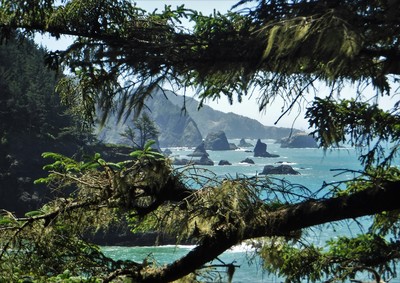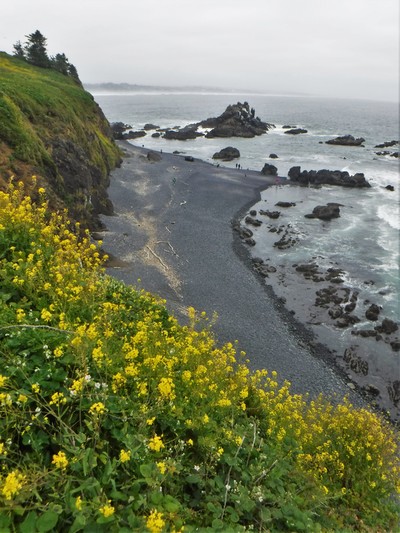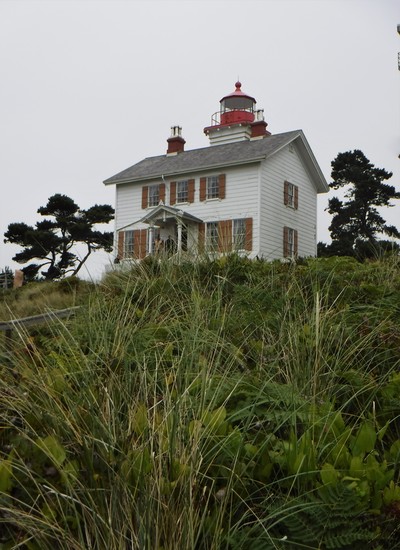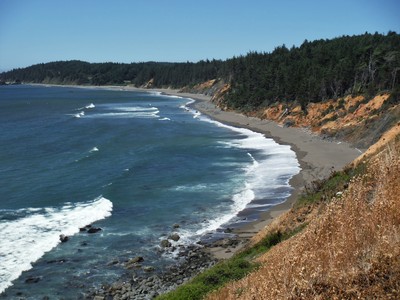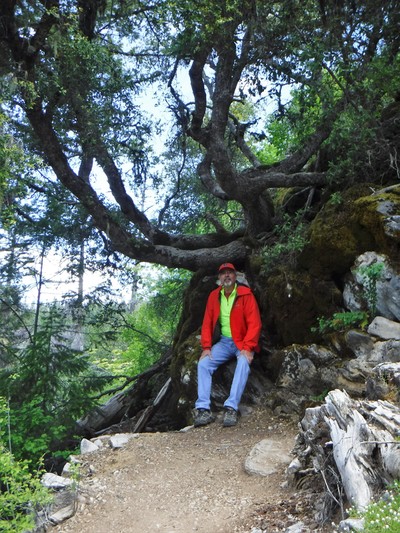where the mountains
meet the sea
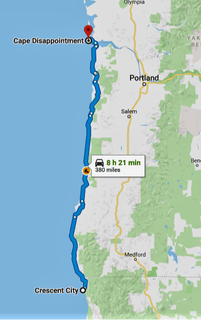
The Oregon coast is about 360 miles long, but we added a few California miles and a little bit in Washington State to our route. In all, we stopped at eleven lighthouses, about as many scenic roadside viewpoints, six beaches, hiked six trails, and visited one-and-a-half forts. Deb got to reach in the candy bag nine times; Ken did not fare so well, usually being the second one in the car to see a light house. Or a fort. Or to note we had crossed a state line.
Several people had recommended this exceptionally panoramic road trip -- we wanted to see it for ourselves. Unfortunately, a storm tried to move across the coast on one of our tour days, so the "exceptional panoramas" were sometimes a bit monochrome inside the fog, but the other days were spectacular!
Oregonians don't refer to this saltwater state-line as a simple beach, and it is easy to understand why once you get a peek. Words alone are inadequate to describe the eminent, endless Pacific horizon, edged by a dramatically bouldered coast, and punctuated by historic harbors, coastal villages, and 'art deco' bridge-spans. There are precipitous lighthouses, pods of frolicking whales (can whales frolic?), climactic surf, secret bays, and countless miles of redwood-topped, mountain grandeur. It was scenery overload! So, no more words -- pictures will have to tell the rest of our story....
"...Where seagulls soar over a sunlit bay.
Perhaps, someday, we'll meet again,
And talk of happy times.
Where salty breezes sway tall trees,
And the mountains meet the sea..."
--excerpt from poem by Dee Daffodil
But until today, I have never been in a cave like the one at Oregon Caves National Monument. First, it is a cave that is in the top of a mountain -- I think of caves usually being found in lowland areas. And second, it is not a limestone cave. According to the Ranger, excluding boulder piles, sea caves ("grottos"), volcanic origin caves ("tubes") and glacial caves ("ice caves"), all but three of the dominant caves in the United States are formed by the acidic water erosion of limestone. Oregon Caves is one of the three that are not limestone caves. The cave here is almost entirely water-eroded marble! Albeit unpolished marble, Oregon Caves has been nicknamed, "The Marble Halls of Oregon."

The Discovery Tour was about one mile, 500 stairs, and ninety minutes. The Park Ranger leading our tour was once "dishonorably dispatched" from The Gong Show, so there were quite a few bad jokes to distract me from the throbbing knot on my forehead (I misjudged a low, 45" passage). The temperature is quite cool inside at 44 degrees year-round. If you go on the tour, reservations are encouraged.
The summit of the tour finds you exhaled through a different cave orifice than the one you entered. When you finally see daylight again, you are about 220 feet higher on the mountain, and eight-tenths of a mile farther away from the Visitors Center. The self-guided trail back, however, takes you outside, up, over the top of the same dome that you saw on the tour, from beneath, just a few minutes before. The view from the mountain's acme is worth the extra hike (see the picture on the title slide of this blog entry). If you like wild flowers, the hike will be even more enjoyable.
On our way back to the car Deb and I agreed that this was one of the most interesting cave tours we have been on. And the first cave where we had to demonstrate we could squat-waddle like a duck before going on the tour. We give it two bat-thumbs up!
oregon at elevation[Ken 06/02/2018] We heard about a new park facility in the area -- officially added to the US roster of parks in 2017 -- we just had to go and explore it. Cascade–Siskiyou National Monument preserves the unique columnar shaft geology of two converging mountain ranges: the southern Cascade Range and the eastern Siskiyou Mountains. At 6000 feet in elevation, the altitude is not high by Colorado standards, but with all of the snow-capped peaks around, it sure felt like Colorado! |

Several foot trails cross the national monument including the scenic and well-traveled Pacific Crest Trail, and we noted that the PCS goes right by Pilot Rock. That's all we needed to know -- there is a trail that will lead us to Pilot Rock! And it starts at Siskiyou Pass, almost to California and the highest point on Interstate 5. Challenge accepted! We were on our way!
| | Off the Interstate, after a couple miles of rough-and-rocky roads, we located the trailhead near an abandoned quarry. Jarred and rattled, Gadget was ready to get out of the shaking car and onto some solid ground (Deb and me, too!). So we were off on what would become a day-hike of long switchbacks, volcanic climbs, and spectacular panoramic scenery. |
In 3.79 miles, we rose just under 1000 vertical feet. By "we" I mean Deb and me and Gadget. Gadget has become an intrepid hiking companion. Its amazing how far and how fast she can go on a few laps of water and a couple crumbs of beef jerky! Too bad that she was too short to see all of the amazing scenery!
We arrived at the park gate at the same time as the hundreds of other curious and hopeful tourists to Crater Lake on this day. As the assortment of cars, RVs and tour buses squeezed through the gauntlet of entrance stations, we all had the same question of the presiding ranger in the booth. And we all heard the same answer, "Due to accumulated snow, all of the rim roads are closed except for a short section of the western rim drive...". Bummer!
We proceeded, regardless -- Crater Lake was on Deb's 'Bucket List' and we needed to cross it off. At the rim village we eagerly assumed the last remaining parking space and slogged out into the snow. It had been several years since Deb and I had hiked in snow, and the first time ever for Gadget. It was actually a pretty reminiscent sensation, and Gadget liked it, too.
| | Crater Lake is famous for its deep blue color and for the clarity of its water. The lake rests in the caldera of an extinct volcano at the elevation of 6178 feet above sea level; the rim rises another 2000 feet(+/-) above that. Crater Lake is the deepest in the United States -- measuring 1943 feet deep (ninth deepest lake in the world). It is worth the drive to see, even if you don't get to more than one vantage point. |
Unfortunately, we were not able to access any "up top" trails. And because of tour bus congestion in snow-clogged parking lots, we did not access any of the short section of the rim drive that had been plowed. But we did access a hiking trail to a beautiful waterfall outside the park. And a tasty meal and a slice of huckleberry pie at 'Beckies Place' on the way back down-the-hill. Yummmmm! Worth the trip!
dog paddle
not required
| |
She was a good lookout -- calling attention to all of the doggies romping on the shoreline and paying especially close attention when a fish jumped or a bird flew near. It was her first time to cross the state line into California, and Ken's first time to kayak across a state line. Fortunately, Ken and Deb did all of the paddling -- no doggie paddle required this time. WooHoo!



